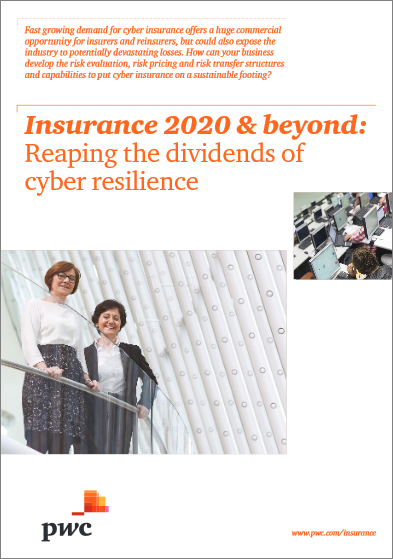PwC: Insurance 2020 & beyond
September 17 2015
Welcome to ‘Reaping the dividends’ of cyber resilience, the latest viewpoint in PwC’s Insurance 2020 and beyond series
Cyber insurance is a potentially huge, but still largely untapped, opportunity for insurers and reinsurers. We estimate that annual gross written premiums are set to increase from around $2.5 billion today to reach $7.5 billion by the end of the decade.
Businesses across all sectors are beginning to recognise the importance of cyber insurance in today’s increasingly complex and high risk digital landscape. In turn, many insurers and reinsurers are looking to take advantage of what they see as a rare opportunity to secure high margins in an otherwise soft market. Yet many others are still wary of cyber risk. How long can they remain on the sidelines? Cyber insurance could soon become a client expectation and insurers that are unwilling to embrace it risk losing out on other business opportunities if cyber products don’t form part of their offering.
In the meantime, many insurers face considerable cyber exposures within their technology, errors & omissions, general liability and other existing business lines. The immediate priority is to evaluate and manage these ‘buried’ exposures.
Critical exposures
So why is there so much scepticism over cyber insurance? Part of the challenge is that cyber risk isn’t like any other risk insurers and reinsurers have ever had to underwrite. There is limited publicly available data on the scale and financial impact of attacks. The difficulties created by the minimal data are heightened by the speed with which the threats are evolving and proliferating. While underwriters can estimate the likely cost of systems remediation with reasonable certainty, there simply isn’t enough historical data to gauge further losses resulting from brand impairment or compensation to customers, suppliers and other stakeholders (as we explore later, new scenario-based techniques are needed). A UK Government report estimates that the insurance industry’s global cyber risk exposure is already in the region of £100 billion ($150 billion), more than a third of the Centre for Strategic and International Studies’ estimate of the annual losses from cyber attacks ($400 billion). And while the scale of the potential losses is on a par with natural catastrophes, incidents are much more frequent. As a result, there are growing
concerns about both the concentrations of cyber risk and the ability of less experienced insurers to withstand what could become a fast sequence of high loss events.
-
SIRC: Distinct reinsurance solutions are emerging to address emerging capital strategies: Guy Carpenter
- November 4
As insurers improve their understanding of the risks they are carrying and capital productivity, structured reinsurance and alternative sources of reinsurance capital are being increasingly considered, Guy Carpenter’s Justin Ward says.
-
QBE’s Hammond on transformation and growth
- July 2
The Asia chief executive discusses Covid-19, going digital and restructuring.
-
Swiss Re: Nat cats and man-made disasters in 2018
- April 10
Climate change, increased urbanisation and a growing concentration of assets were on the risk agenda for 2018.
-
Willis Towers Watson: 2019 Asia Market Report
- March 19
Economic uncertainty, more complex risks and tighter underwriting are all influencing Asia's markets.
-
Beazley | What does cyber protection look like from day 1 to day 600 and beyond?
Cybersecurity is no longer just an IT concern, but a governance issue that belongs on the boardroom agenda.
-
Sedgwick | Preparing for the next storm
Insurance industry needs to recalibrate, invest in innovation and strengthen systems, talent and data practices.
-
Peak Re | From climate modelling to market opportunity: Forging a new clarity on Southeast Asia’s climate risk
Southeast Asia's protection gap: a crisis of clarity, not just capital
-
BHSI WICare+ | Accelerating Payments, Empowering Recovery
Launched in cooperation with Steadfast’s Singapore network, WICare+ fills the gaps found in traditional coverage and keeps businesses and their workforce secure by covering up to SG$350,000 in medical expenses per claim.

